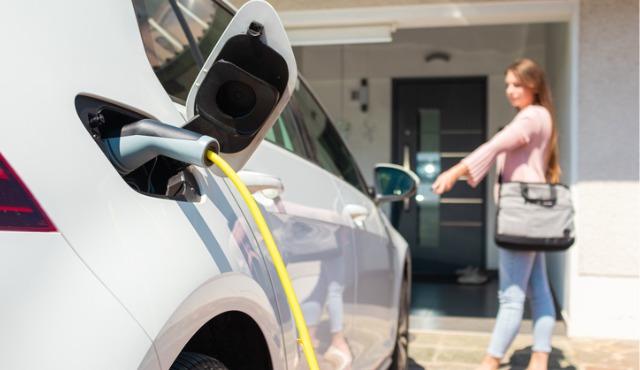By Brentnie Daggett, Rentec Direct
Electric vehicles (EVs) and hybrid-electric vehicles (HEVs) are gaining popularity across the globe—in the U.S., with EV sales nearly doubling from 2020 to 2021 and HEV sales up even more. If you’re considering adding an electric vehicle to your fleet, there are a few things to consider when it comes to charging it at your home.
How does EV charging work?
Plugging in a device to charge seems like a straightforward process, but things get a little more complicated when it comes to the electricity requirements for an EV. Just like there are different types of gasoline, there are different levels of EV charging—each of which has a different set of requirements and provides a different level of charge for your vehicle.
- Level 1 is the most basic level of charging which involves simply plugging into a normal wall outlet (like any other electronic device). Every EV sold in the U.S. comes with a 120-volt Level 1 charger, using an extension cord to run to any outlet.
- Level 2 charging requires 240-volt electricity (similar to electric dryers, water heaters and some HVAC equipment) and a separate charging device, but will typically give you more miles per charge. Level 2 chargers can range in power depending on the device, and can also be portable or mounted. This is usually the most common type of at-home charging device and is also commonly found at public charging stations.
- Level 3 is the most powerful level of charging, typically requiring over 800-volt electricity to rapidly charge more than one EV. These chargers are usually more difficult to install and certainly more expensive than the other options, but they will provide your EV with the most amount of miles in the shortest amount of time.
Should I install an at-home EV charger?
Put some careful thought into the decision to add an EV charging station at your home. While the Level 1 charging won’t require any installation or additional hardware, it will impact your electricity bill—costs will range depending on how many miles you drive each week (one industry expert estimates an average of $60 per month). It is also worth noting that Level 1 charging can take multiple days to reach full charge—you’re looking at about three to five miles of range per hour of charging.
If your EV is your primary vehicle and/or you are regularly commuting long distances, Level 1 charging might not suffice. Before you decide to install a charging station at your home, consider where others might be available to you. Does your employer offer EV charging? Are you nearby any reliable public charging stations? Try to get a sense of how busy your local public chargers might be so you know if they will be available to you when you need them.
You will also need to consider the details of your home and property to determine if installing a charging station is available to you. For example, if you don’t have a driveway or garage, where would you install a personal charger?
Another way to offset costs and reduce strain on electricity grids is to install solar panels or another sustainable option to provide power for charging your EV. Solar panels are a cost-effective way to “fuel” your EV while producing zero carbon emissions. Some areas also offer rebates and incentives for this installation, which can further offset costs while adding value to your home.
The costs of installing EV charging at home
Typically, your largest cost associated with at-home EV charging will be the associated electricity bill, but installation and setup fees can add up depending on the type of device you choose. Some level 2 chargers can be simply plugged into an existing outlet designed for a high-voltage appliance, which is often conveniently located in a home’s garage. That said, you may need to hire an electrician depending on the wiring and voltage of your home and the requirements of the specific charger you choose. If you have any neighbors who may be interested in EV charging, consider installing a station in a communal or easily accessible area to split up or offset some of the costs.
Like most of your decisions as a homeowner, there are pros and cons to weigh out before deciding to add at-home EV charging to your property. It certainly seems like EVs and HEVs will only continue to grow in popularity, and installing an electric car charging station on your property is likely to boost its value and make it more attractive to potential buyers. It’s not a bad idea to start looking toward the future.
 Brentnie Daggett is a writer and infographic master for the rental and property management industry. She loves to share tips and tricks to assist landlords and renters alike. To learn more about Daggett, and to discover more great tips for renters, visit www.rentecdirect.com.
Brentnie Daggett is a writer and infographic master for the rental and property management industry. She loves to share tips and tricks to assist landlords and renters alike. To learn more about Daggett, and to discover more great tips for renters, visit www.rentecdirect.com.








